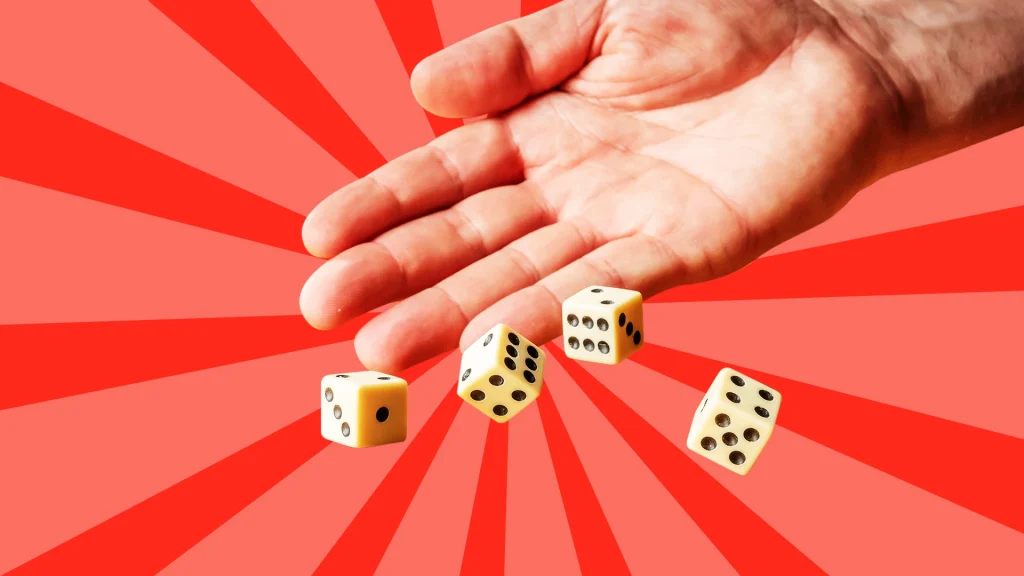TUMBLIN’ DICE And the People Who Try to Control Them
Walk through any casino, and it’s easy to know where the action resides. Almost invariably, it is at the craps table. People crowd in, they stare down the shooter, call out for bets like boxcars, hard way, and the field. Then the all-important shooter shakes a pair of dice, releases them with a flick of the wrist, and sends those cubes tumbling down the felt. They bounce off the back wall and land on numbers that decide the fate of chips spread from one end of the table to the other.
If it’s a winner, the crowd cheers wildly as payouts get made.
On some nights, when everything goes as desired, piles of chips flow to the gamblers and energy levels become so palpable that it feels as if the table will levitate. Unlike a lot of casino games, craps is a group effort. Most everyone (except for the dreaded “don’t” players) teams up against the house. At the dice table, it’s designed to be one for all and all for one.
Playing craps is fun and easy. Online as well as in brick-and-mortar casinos, the game begins with a come-out roll. People put up money on the pass line. If the dice hit 7 or 11, the gamblers win immediately; if they come 2, 3, or 12, the house wins; if they total 4, 5, 6, 8, 9, or 10, a point is established. From there, players make all kinds of proposition bets – like wagering that two 5s will hit for a 7-1 payout – as well as taking odds on the point being made before the shooter rolls a 7 and craps out.
Beating craps consistently is the dream. Some people claim that they can control dice and, thus, legally influence the game’s outcome. A guy who calls himself the Dice Coach maintains that “dice control is a skill, and you can be trained to become a controller shooter.”
Frank Scoblete is a dice fanatic who wrote a book called The Golden Touch! Dice Revolution. In its pages, he maintains that people can indeed be taught to roll dice advantageously
Never mind that thrown dice become uncontrollable once they hit the back wall with any degree of velocity. There are people who whole heartedly maintain that “muscle memory” can be used to control the dice to a degree. They believe that a game of chance can be turned into a game of skill.

In other words, the thinking is that the ordinarily luck-based gambit of craps can be transformed into an advantage play, Advantage players, to put it simply, play games advantageously. They typically employ legal methods such as card counting, shuffle tracking, hole carding to gain edges on casino games such as blackjack and Ultimate Texas Hold’em. Dice control is required for consistently beating craps.
A highly regarded advantage player who goes by the name Stanford Wong got bit by the craps bug in 2011. He even wrote a book called “Wong On Dice.” It maintained that by setting the dice a certain way, you could throw 7s less than 1 out of 6 times. Anyone who does that successfully, and manages to get down decent sized bets, would have a good shot at becoming a dice-throwing millionaire.
Back around that time, when there was a bit of a frenzy around overcoming physics and beating craps, I did a story on believers in dice control and went to the old Las Vegas Club with Wong and a group of his friends. Not long before our meeting, Wong’s credibility rose significantly after he won a wager made with a group of sharp gamblers. Wong believed that he could roll the dice 500 times and hit 7 only 80 times. That would defy the odds and make Wong into a winning craps player.
He did it, won money at the table, and aced the wager among his gambling cohorts.
On the afternoon when I met with Wong, he left me astounded and financially fortified. Wong threw the bones for 70 minutes before crapping out. It was an amazing performance and seriously reduced my skepticism about dice control.
Wong was not alone. Even the poker pro Phil Ivey had a serious interest in craps, as evidenced by the fact that, years later, when I interviewed him for Playboy magazine, he had a regulation size craps table in his apartment. Another of the dice faithful was a man who goes by the name of Frank B.
Frank is one of the most successful and astute advantage players out there. Not coincidentally, he and Ivey both appear in my appropriately titled book Advantage Players: Inside the Winning World of Casino Virtuosos, Master Strategists, and Mathematical Wizards. Ivey was at the center of a multi-million-dollar baccarat play with Kelly Sun. Frank created betting strategies for Jim “Mattress Mack” McIngvale. Mack became famous for wagering eight-figure sums on high-profile sporting events in order to balance out promotions for his chain of furniture stores in Texas. When it comes to gambling, none of the people named in this paragraph mess around.
Like Ivey, Frank purchased a casino-worthy craps table. Frank’s table came from the same manufacturer that made them for Wynn Las Vegas. He knew it was the real thing and spent hours each day, working with a team of professional blackjack players, to perfect his dice rolling.

“We had a dedicated place and a dedicated table,” Frank said on the podcast Gambling with an Edge [https://podcasts.apple.com/dk/podcast/gambling-with-an-edge-guest-frank-b-on-dice-control/id459476611?i=1000520531943]. “We had a dice tracking program. The shooter would throw the dice and put the result into the computer. We were hoping to each get 200 rolls per day.”
The vaunted goal was to avoid throwing 7s. To accomplish that, they needed to toss the dice softly, have the cubes land a few inches from the wall, and make as little contact as possible with the wall. “On a good throw, the dice would kiss the wall,” said Frank who accomplished this consistently. “You can control 100 percent where the dice land. But you cannot control what happens [after they hit the wall].”
Frank and his partners labored to throw the dice so that they landed in such a way as to avoid making 7s and to have as little contact as possible with the wall. Amazingly, it worked. They found casinos with old tables that had very little bounce. That condition favored the advantage playing rollers. They played those tables on a regular basis and realized five-figure profits.
The group-members bet high, aimed to erase the house edge, and benefitted from comps and inducements (such as free chips and invitations to freeroll tournaments) that get extended to elite gamblers. After all, casinos consider craps to be a luck-based game with a house edge. Frank and company knew otherwise.
He and his collaborators made decent money. But, over time, the casinos got tired of their winning ways – and their avoidance of smacking dice into the wall. He recalled “being bounced” from many of Las Vegas’s gambling dens. More precisely, he was told that if he didn’t clearly hit the wall, he would no longer be allowed to throw dice. It was the equivalent of getting half-shoed for card counting.
Hence, for Frank, his advantage playing at dice was eventually eclipsed. One way or the other, Wong’s enthusiasm for winning at craps met a similar end.
On the upside, they both proved that dice can be controlled and that the game is beatable.
According to Anthony Curtis, publisher of Las Vegas Advisor and a sometime gambling partner of Frank B., “Frank thinks there is something to dice control and that it can be implemented. But he couldn’t do it in the real world and get away with it for any decent amount of money and for a decent period of time. Some things are doable but difficult to cash in on.”
Dice control may rank among those things.
Nevertheless, craps remains one of the most popular games on any gambling floor and on Cafe Casino. No doubt, people are still working hard to control the dice that get thrown. So, if you’re playing the game in a brick-and-mortar casino, why not try to play profitably? After all, everyone wants to overcome the physics of tumbling dice, one money-making roll at a time.
About the Author:
Michael Kaplan is a journalist based in Brooklyn, NY. He is the author of five books. The most recent one is Advantage Players: Inside the Winning World of Casino Virtuosos, Master Strategists, and Mathematical Wizards. Kaplan has written for publications that include the New York Times Magazine, Wired, and GQ. He is a senior features writer with the New York Post, writes the gambling column for Cigar Aficionado, and wrote an article on baccarat queen Cheung Yin “Kelly” Sun that is being developed into a feature film with the actress Awkwafina attached to star as Kelly.
Disclaimer: The information provided in our casino blog posts is for educational and entertainment purposes only. While we discuss popular casino strategies and offer tips for various games, please note that no strategy can guarantee a win. Casino games are based on chance, and outcomes are unpredictable. We encourage all players to gamble responsibly and never bet more than they can afford to lose.